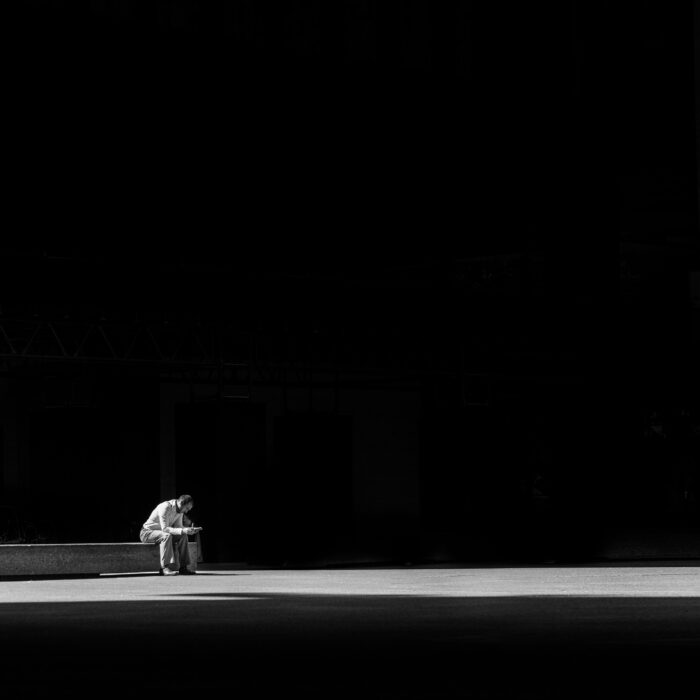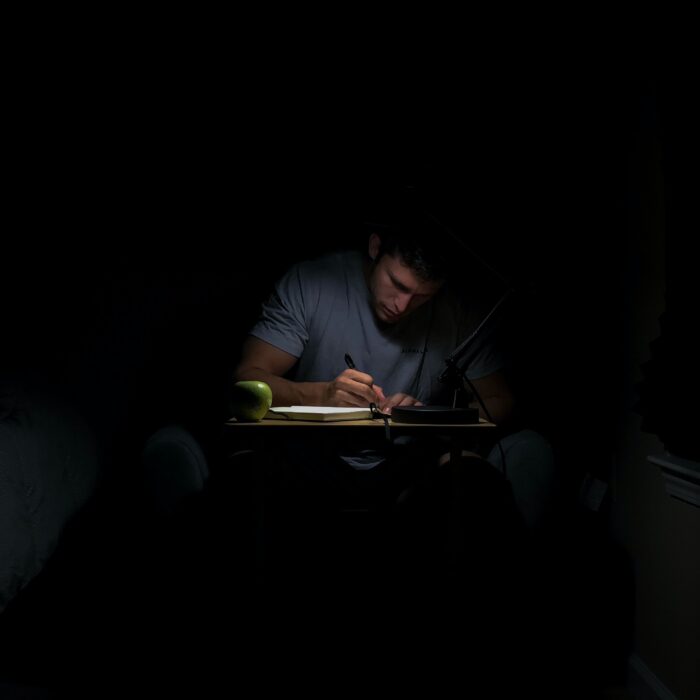You have no items in your cart. Want to get some nice things?
Go shopping
On the estate where I grew up there was a woman who delivered the free newspaper. She had stubble all over her chin and on the rolls of neck beneath. She walked from door to door, pushing the newspapers in a brown shopping trolley. When I was sixteen, I worked in the greengrocer’s shop and she came in every Saturday morning – early. She smelled so bad I had to turn away when I took her money. It wasn’t a human smell. It was earthy and rotten, like the smell the old potatoes made when they decayed and leaked tar-like liquid in the bottom of their trays. I was sure the smell leaked like tar from her vagina. The cracks in her hands were filled with dirt and I dropped the coins into the till as quickly as I could.
It was my job, every Saturday afternoon, to clean all the mirrors in the shop. There were mirrors lining all the walls behind the double decks of vegetables. In the mirrors, in the fluorescent shop lights, I bared my skin. I noticed three dark hairs above each corner of my top lip. I also had one dark whisker that grew from a mole on my jawbone and another that sprouted under my chin. My face and my hairs were multiplied across the shop
and by the hair of my chinny chin chin,
I headed straight home
for mum’s magnifying mirror
and plucked at my skin –
hunting for more.
I begged my best friend to lie under a magnifying glass and I scanned every woman I met, especially the beautiful ones. I couldn’t look at the free newspaper lady.
I ran my hand along my chin – my fingers worried for whiskers. The bristles pierced my sleep. I saved up and booked myself into a beauty parlour. My friend asked if I needed a beautician or a psychiatrist. I started to think I might need both.
In Elena Ferrante’s The Days of Abandonment, the poverella is the abandoned woman who loses everything, “for everyone she became the ‘poverella,’ that poor woman.” The poverella is abject, “I was ashamed for her, she no longer took her children with her, she no longer had that good smell.”[1] Always on the periphery of Olga’s vision, “I saw the poverella of so long ago, who said to me in a weary but serious tone: ‘I am clean I am true I play with my cards on the table.’”[2] If these things are not enough to remain loved, then those of us who fall short have even smaller chances.
Between childhood and adulthood, the newspaper woman drifted on the border of my vision – her chin and mine became one – a pubic mound.
Women grow whiskers during hormonal imbalances, most typically during puberty, after childbirth, or during the menopause. After childbirth the newspaper woman returns to me and my skin can no longer be trusted to contain her.
“In the first place, filth is not a quality in itself, but it applies only to what relates to a boundary and, more particularly, represents the object jettisoned out of that boundary, its other side, a margin,” says Julia Kristeva.
When I gave birth, they cut my vagina with scissors. Five snips turned my flesh into five fronds. My uterus repulsed the baby. My vagina sucked the baby back in and the fronds closed over his head. My uterus contracted again and if the doctors had not caught the baby’s dark crown in their plunger and pulled him out, I expect my body would probably still be there. My vagina would still be pulsating on the birthing table like a sea anemone.
“She is the ‘abject’ who threatens the tenuous boundary between the not-yet-subject and the not-yet-object,” writes Marianne Hirsch.[3]
After the birth, my borders would not close easily. The doctor stitched me up, joining the five fronds together, but there wasn’t a part of me that didn’t leak: eyes, urethra, vagina, nipples, arse. In the first few days, I bathed as often as I could bear. Letting out pathetic whimpers, I crouched in a bath and paddled water into my crotch. Flinchingly. Quickly – in the time I snatched from the baby. Then I’d hear him wail.
Prising the baby off was like tearing away a strip of skin. I was too squeamish, and instead, I held him most of the time. Constantly holding a baby made washing my new vagina difficult. When the community midwife did her rounds, she ordered me upstairs to inspect my stitches. I lay on the bed, skirt hitched past waist, legs spread, panting for approval. She winced, then said, “Done a good job, whoever did it. Must’ve taken a while. Try to keep it cleaner.”
“It is thus not lack of cleanliness or health that causes abjection but what disturbs identity, system, order,” says Kristeva.[4]
On the subject of vaginas, a physician called Jean Palfyn wrote, in 1708:
“There are none in the body that are uglier and more subject to several very loathsome ailments, often infected with contaminated blood and much filth. They are soiled and soaked each day by urine and emit a stinking and sulfurous odor, and they are relegated by the Author of Nature to the most contemptible place on the body, as if not fit to be seen, right near the Anus and its Excrements; they are themselves the main sewer for all elements. It is here, I say, in these bodily parts, into which all nature’s filth flows and accumulates like a pit, that the Author of Nature nevertheless wanted Man—”[5]
Palfyn seems to be channelling King Lear,
Beneath is all the fiends’; there’s hell, there’s darkness,
There’s the sulphurous pit, burning, scalding,
Stench, consumption! Fie, fie, fie! Pah! pah! (4.6.121–26).
Both Palfyn and Lear fear the monstrous place that women hide; and they fear that, from this monstrous place, men are born.
Teratology is “the study of monstrosities or abnormal formations in animals or plants”.[6] After childbirth I started to think of my vagina in teratogenic terms. The blood and mucus that leaked from the uterus clogged with the pus and scabs from my wounds and matted with my stitches and pubic hair. A teratoma is a rare form of tumour, containing hair, blood, bone, muscle (and sometimes teeth).
It is like human pelleted by an owl.
A uterine teratoma should not be confused with a molar pregnancy, although both are growths of abnormal cells. And a molar pregnancy has nothing to do with teeth (“molar” comes from “millstone”). I’ve also heard that moles have no teeth, but a quick search of the internet reveals they do. The have some very small ones.
My vagina seemed
a teratogenic
toothless mole.
A teratogen is a drug that causes “malformation in the developing embryo”. Thalidomide is a famous teratogen – a drug originally intended as a sedative.
In Doris Lessing’s The Fifth Child, Harriet is heavily pregnant when David tells their four existing children a story. In the story a young girl looks into a pool:
“But she saw something that she didn’t expect. It was a girl’s face, and she was looking straight up at her. It was a face she had never seen in her whole life. This strange girl was smiling, but it was a nasty smile, not friendly, and the little girl thought this other girl was going to reach out of the water and pull her down into it […] As for Harriet, she was wanting to cry out, ‘Stop – stop it! You are talking about me – this is what you are feeling about me.’”[7]
Throughout the pregnancy Harriet fears the that she’s carrying a monster but she also fears she is becoming a monster. The baby kicks her so violently that she begs the doctor for sedatives (teratogens?) He prescribes them – believing she’s having a breakdown. She administers them to the foetus as a form of restraint, “The drugs did not seem to be affecting her much: she was willing them to leave her alone and to reach the baby.”[8]
Ben, this fifth child, is monstrous and Harriet understands that her monstrous “throwback”, her “goblin” child, reveals her own monstrosity: “Even David, she believed, condemned her. She said to him, ‘I suppose in the old times, in primitive societies, this was how they treated a woman who’d given birth to a freak. As if it were her fault.’”[9]
Childbirth leads to Harriet’s abjection from society. The doctors, who Harriet consults over Ben, also suggest it is Harriet who is the monster, “I’m going to come straight to the point, Mrs Lovatt. The problem is not with Ben, but with you. You do not like him very much.”[10]
Ben’s violence (as a toddler, he kills the family pet) means that he must be constantly watched by Harriet. She has no time for the other children and the extended family conspire against Harriet to have Ben locked in an institution. Harriet is told he will be sent away – for the safety of the other children – and the next day a van arrives for him. No one will tell Harriet where he’s been sent and, initially, she doesn’t ask. Just like the Minotaur, he is locked in a labyrinth – straightjacketed and drugged until Harriet breaks under the guilt and breaks him out.
Freud theorised that all young boys fear castration and they view their mother as a castrated male. When my eldest son was three, he asked me what was inside my “underground hair”. I was stumped, having not yet decided what I was going to name it; having not yet decided how I was going to describe it.
“A hole,” I said, unable to think of anything else and ashamed about this inadequacy.
A few days later, with friends in the park, I crouched down and my son kicked a ball between my legs.
“I’m sorry, mummy, I nearly kicked you in your hole.”
“Of course you encounter opacity and resistance in her, as well as the repellence of matter, the horror of blood, the ambivalence of milk, menacing traces of the father’s phallus, and even the hole we left behind us when we came into the world. But she – at least – is not nothing. She is not that vacuum (of) woman,” writes Luce Irigaray.[11]
A mother who clings too hard is often seen as monstrous. She is gum. The child has to escape the mother’s sticky hands in order to see the lines that delineate themselves. The child needs to wash the mother’s blood from their hair and filth from their skin. As a mother, I became the excrement that my children must wash away to create their clean and proper bodies. However, when reading this paragraph, you could interchange mother and child. It is stickiness that threatens the sense of self and leads to abjection.
Sartre said, “I remain a solid. But to touch stickiness is to risk diluting myself into viscosity. Stickiness is clinging, like a too possessive dog or mistress.”[12]
In Elena Ferrante’s The Days of Abandonment, Olga sees her daughter, Ilaria, dressed up in her makeup and her clothes:
“…she looked to me like an old dwarf… When she became aware of the revulsion that must have shown on my face, the child smiled in embarrassment, and eyes sparkling, said, as if to justify herself:
‘We’re identical’
The sentence disturbed me, I shuddered, in a flash I lost that bit of ground I seemed to have gained. What did it mean, we are identical, at that moment I needed to be identical only to myself.”[13]
This child is abject.
Becoming a mother opened my borders and made me border. The sperm stabbed my egg, but instead of yolk dripping from my vagina, the sperm disappeared.
The embryo is uncanny. Fragments of me
joined fragments of another
and became other.
“Birth is not merely that which divides women from men; it also divides women from themselves,” writes Rachel Cusk. [14]
[1] Elena Ferrante, The Days of Abandonment, (New York: Europa, 2005), p.16.
[2] Ferrante, The Days of Abandonment, p.87.
[3] Marianne Hirsch, The Mother/Daughter Plot: Narrative, Psychoanalysis, Feminism, (Bloomington: Indiana University Press, 1989), p.171.
[4] Julia Kristeva, Powers of Horror, (New York: Columbia University Press, 1982), p.4.
[5] Jean Palfyn ‘Description anatomique des parties de la femme qui servent à la génération, avec un traité des monstres, de leurs causes, de leur nature et de leurs différences’, quoted in Huet, Monstrous Imagination, p.59
[6] “teratology, n.” OED Online. Oxford University Press, June 2020.
[7] Doris Lessing, The Fifth Child, (London: Harper Perennial, 2007), p.54.
[8] Lessing, p.53.
[9] Lessing, p.74.
[10] Lessing, p.124.
[11] Luce Irigaray, The Irigaray Reader, ed. Margaret Whitford, (Oxford: Blackwell, 1991), p.54.
[12] John Paul Sartre, Being and Nothingness, trans. H. E Barnes, (New York: The Philosophical Society, 1956), pp. 606 – 607.
[13] Ferrante, p.120.
[14] Rachel Cusk, A Life’s Work: On Becoming a Mother, (London: Fourth Estate, 2001), p.7.

About Stephanie Limb
Stephanie Limb graduated in English Literature and Creative Writing at the University of Warwick in 2003. She worked as an English teacher for a while. She is now working on a creative-critical PhD at the University of Nottingham. She writes poetry and prose. Her book My Coleridge is out with Broken Sleep Books, October 2020.



